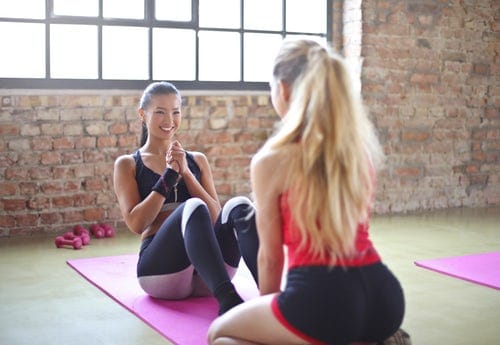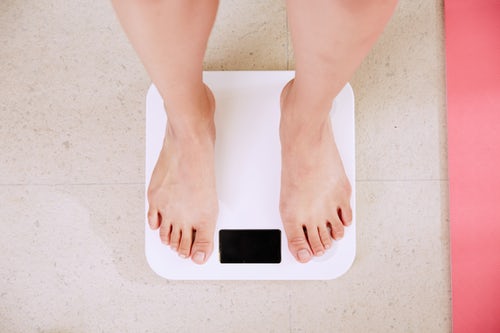I asked myself this question so I could learn how a widely performed exercise like sit-ups compares to inline skating for getting a six-pack. I’ve distilled down what the experts say about what gets you defined abs, which out of the two exercises work better and why…
So, does inline skating work out your abs better than sit-ups? Sit ups, crunches in particular, and bicycle sit-ups especially, target your abdominal muscles more than through the stabilising role they play in inline skating, but the skating activity burns more fat which is the key to a six-pack. Rollerblading may help you get abs sooner if you have a layer of fat to burn away.

However, this doesn’t mean that you should throw out the sit-up routine and just skate all the time, you have considerations like intensity, time spent exercising, and movement of different muscle groups, which are outlined below.
Which Will Get Me A Six-Pack Faster If I Have To Choose One?
The abs consist of two main parts – the rectus abdominis (six pack bit) and the obliques (side parts).
In the case of getting a six-pack or firming up your stomach you need two things.
- To have those muscles built up well:

2. To remove all that fat around the muscles so you can actually see them.
It turns out that sit-ups help you get those muscles whereas rollerblading is better at removing all the fat around your body so you can see them.
But if you had to choose one which would work faster? Well, it depends whether you need to remove more fat or get more muscle. You probably need to remove more fat, so rollerblading.
In sit ups you are contracting these muscles to bring your head off the floor, and a large proportion of your work is done by these muscles (and maybe a few others like your chest, depending on your form). So, sit-ups are great for building the muscle.
During inline skating your torso is being held bent forward as your legs push out and your arms pump. So skating requires the abdominal muscles to produce force, balance your body and stabilise your spine. You also work a deep abdominal muscle called the transverse abdominis, worked when you draw your stomach in during breathing, very important for your core.
But the main difference comes from how much fat you burn. Now it’s widely considered that “spot fat reduction” doesn’t really happen (though some views differ), so it’s not like you can target your belly fat but just lose fat generally and pray it’s belly fat.
But ultimately, you burn more fat rollerblading in the same amount of time than you doing if you ONLY did sit ups because you don’t spend as long doing sit ups.
How Many Calories Do Sit-ups And Rollerblading Burn?

If you’re a 185lb or 84kg human, with 30 minutes of inline skating you burn 311 calories (according to Harvard Health Publications)
Compared to that, sit-ups will burn between 135 – 200 calories in 30 minutes (well, 30 minutes of calisthenics will, according to Harvard Medical School, and that’s basically the same)
However, are you going to do 30 minutes of just sit ups?
Let’s say you do 100 sit ups in 6 minutes, that’s 40 calories.
It’s keeping your heart rate up that matters and performing intense cardio for a longer duration will help you lose weight. But then if you’re actually talking about abs, they’re extremely difficult to get your body fat percentage down to the below around 14% you need for abs to show. That’s very low, and it means you have to eat nothing but the right amount of good food for months and months whilst doing all the exercise with no slip ups.
Finally, if you’re aiming for ab muscles sit-ups might not be your best choice, as research indicates it goes planks, crunches and sit ups in order of effectiveness.
Won’t Rollerblading Be Bad For My Back?
If you skate with bad form and tight hips for very long periods of time without a strong enough core, and if you repeatedly fall backwards on your back, then it’s not going to be great. Holding up your body weight leaning forward without a seat or bars to support you puts more pressure on your back and abdominals, and if you’re hips are too tight might not be ideal for your back over very long periods, so says Ricci Porter, director of USA Roller Sports and several time national champion of speed skating, with some agreement from The Wharton’s Back Book by Jim Wharton and Phil Wharton.
Get The Form Right:
If you use right form, and have the right muscles developed, skating should be fine for your back.
Make sure your knees are bent. Center you weight more on your heels, with the power coming from pushing your legs out to the side, swinging arms forward and backward at a slight angle, coming slightly in front of your body, cross from one side of the body a bit more than they do when you run. As you gain control, your arm movements will be more purposeful, swinging back and forwards to help your momentum and speed. Lean slightly forward but your shoulders should not go over your knees, your pelvis tucked in, creating almost a straight line from the top of your head to your lower back. May take time developing postural muscles required to sustain this motion.
If you’re unsure about skating, consult a doctor.
Start with shorter sessions and get longer over time if you are a beginner, to get your muscles better.
Equally, the bent-over aerodynamic stance when skating fast can strengthen your lower back. The lower you get, the more you will engage your core (as well as your leg muscles).
What About Breaks During Skating, and Stretching?
You can prevent back strain by regularly stretching your back and trunk as well as doing a warm-up before you hit the pavement with your blades. When rollerblading, take occasional breaks to straighten your trunk and release the tension from your lower back.
Warm up by gently stretching major muscle groups, start at a leisurely pace, and then get up speed later. Cool down and stretch again at the end.
One useful stretch: lie on the floor and bring your knees into your chest. With shoulders flat on floor, roll knees from side to side to stretch the back.
Interestingly, strengthening your core through sit ups and crunches may feed into your skating ability. So too may adding other activities like running, or yoga, to prevent overuse injuries in the back.
Do remember however, as a fluid motion, it’s less bad for your joints because it has less impact on them than other activities like running.
What Other Muscles Does Inline Skating Work?
You displace your centre of gravity in inline skating in a horizontal plane, in a lateral movement, rather than in an up-down motion typical of a lot of other exercises. Moving your legs in and out horizontally, means you will be stretching, flexing and extending your lower body muscles similarly to running and cycling, but slightly different, engaging your hip adductors and abductors more, moving muscles in a way they are unaccustomed to, which can be a good thing.
This is great for the following muscles in particular:
The Glutes – so you can get a great bum from skating a lot, which doesn’t come from all those sit ups.
The Hamstrings – which can help tone up your legs.
The Abductors and Adductors – Your abductors are the small muscles running down your outer thigh that work with the glutes to move your thigh outward. And the adductors are running down your inner thigh to move your leg inwards.
Quadriceps, shins and calf muscles. As you may expect, getting your legs in great shape.
Erector spinae in the back – long back muscle along your spine.
How Can I Vary Rollerblading To Help Out The Stomach Muscles Better?
Get low and go fast (according to Porter), bending you knees, dropping your upper body.
Then, do intervals by skating as fast as you can for anywhere from 30 seconds to a couple of minutes, then roll along or stick at a slower pace. You can do this will hills if you like (make sure they’re not too steep that you can’t control yourself though).
What Exercises Can I Do To Make My Stomach Stronger For Rollerblading?
It’s super important to get a strong core, it helps you get stability and force control during inline skating. Basic exercises use little movements of the spine and hips allow you to feel those core muscles being activated and build endurance in them.
Floorbridge where you lie on the floor, like this.
Or the plank, like this.
Are Sit-ups The Best Exercise To Build Your Ab Muscles Anyway?
According to experts, no. As well as the plank mentioned above, better exercises to build your abdominal muscles include:
Bicycle crunches – which you can see here – which make use of all the abdominal muscles more effectively, including the rectus abdominis (those six-pack ones). These can be pretty difficult, which I suppose is a good sign:
Or, using the captain’s chair, as seen here.
Or the balance ball crunch, as seen here.

